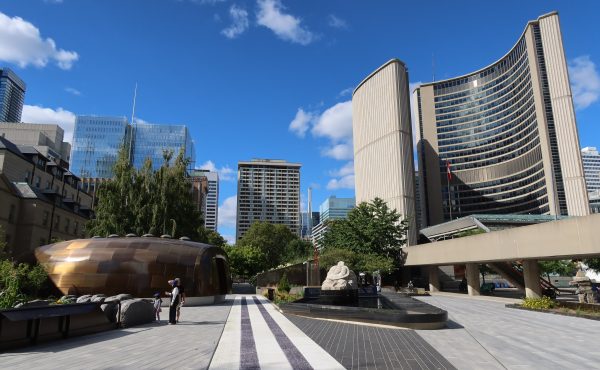
Cross-posted to Spacing Votes
I’ll be highlighting and critiquing some of the campaign literature I come across during the election. The graphical representation of a campaign can say so much about a candidate.
It’s probably best to start with the mayoral candidates since they’ve had material out on the streets for months now.
DAVID MILLER
The incumbent mayor has strong graphics. Certainly, he has people advising and creating literature that know a thing or two about graphic design, copy writing, and branding.
1. Size: A brochure should reflect the personality or platform of the candidate. If any of you have met the mayor in person, he is a large fellow (over six feet) who physically commands your attention. This trait is conveyed in his flyer effectively — by framing the photo in such a way that the top of his head is cropped off and you can’t see much below his knees, you’re given the impression that his a large personality, almost too big to get into a small flyer. In a time where intangibles such as “like-ability” are huge, the cult of personality is one of the driving forces of Miller’s campaign.
2. Colours: Though Miller is continuously called an NDP mayor, he uses his own colours. Blue, a traditional Toronto colour, is a smart choice. It is also a calming colour and fits nicely into his platform which focuses on a clean waterfront. The use of yellow is more practical than anything else: it works with the blue and is bright, especially when placed on lawn signs. These colours were used in 2003 and are wisely being used again to jog voters’ memories.
3. Disclaimer: While most campaign material indicate in small print “Authorized by the CFO of the [insert name] Campaign”, the Miller team has a little fun stating “No tax dollars were harmed in the making of this card.” We see very little humour in any election material, and this is a nice touch even though it is meaningless.
4. Identity: Miller used the broom as an icon so effectively in the 2003 campaign (and on numerous City sanctioned projects and materials ever since) that it has almost become a hinderance. There have been questions about whether the back door to city hall is really closed (see Bombardier deal, landfill purchase), so it was wise to drop the broom and differentiate Miller’s new campaign. Using the old-school street sign as an icon won’t be a lasting image such as the broom (if Miller wins again will he hold up a street sign at his victory party?), but Miller’s team is trying to make sure he is seen as a mayor of all of Toronto. As someone deeply interested in street signs, I don’t mind being cheeky and pointing out that Miller is using the traditional old city of Toronto street signs, not the cheap knock-offs that are currently being installed.
5. Platform & Accomplishments: The back panel is designed nicely. Good use of headers and bullet points, as well as bolding key phrases. Either Miller does not have many accomplishments or the team decided that it is best to keep it simple and highlight only a few items. I suspect Miller has a lot of cash (which means lots of campaign literature) and this is only one of a number of pieces that will be dropped over the length of the campaign.

JANE PITFIELD
1. Identity: Pitfield’s team is using red on yellow, a good colour combo for visual impact on lawn signs. The logo is clunky, and I dislike it when words are turned on their sides just to fit into the space allocated. Whereas Miller has instant name and face recognition, Pitfield, is a newcomer so it is important for her nameplate to be front and centre. But a much more creative logo is needed.
2. Platform: Miller used a statement on the front of his flyer which was big, nicely worded, and central to the design — 12 words in total. Pitfield, on the other hand, uses a quote plus four more paragraphs to state where she stands on the issues. Of note, she says that “crime and violence are out of control.” I associate “crime and violence out of control” in Somalia and Iraq, not on the streets of Toronto. While violent crimes are on the rise, most other crime stats show a marked decline in the last 25 years. I don’t remember any official ever stating crime is out of control in Toronto.
3. Word Play: The word “change” is often used in election literature, and silly word-play is also a common tool. The latter is usually hackneyed, and Pitfield’s attempt is no exception. She uses a CHANGE to highlight her platform: Crime and violence; Hosing and homelessness; Accountability; No tax increases; Garbage solution; Excellent service delivery. If I were on Pitfield’s team, and this feature had to be part of the design, I’d suggest dumping that long-rambling intro and make her CHANGE feature much bigger and the lead item.
I’d also suggest making the photo of Pitfield a thousand times larger than its current size. As I pointed out in Miller’s flyer, his team is portraying him as big and mayoral. Is the photo of Pitfield indicative of how her team views her chances? In a race against an incumbent it is hugely important for Pitfield to be visible, and this flyer fails miserably to make her more recognizable.
4. Grammar? Am I correct to assume that there should be a comma after Toronto in “Toronto we can do better”? Does that matter in copy writing? It was something I noticed right away but I’m second-guessing myself now.
5. Profile: While it’s important to note the accomplishments of a candidate, it should also be done in a nice, graphical manner. This black and white back panel is awash in text that is hard to differentiate from one bullet point to the other. Pitfield’s team should emulate Miller’s back panel for its clear and concise presentation.
WINNER: Miller takes it, hands down. Graphic design and creativity are not cost-prohibitive — all you need to do is find that talent. If Pitfield wants to make an impact during the canvassing part of her campaign she is going to have to create much more effective and attractive literature. The next battle between these two will be lawn signs, which are allowed to go up starting October 19th.



